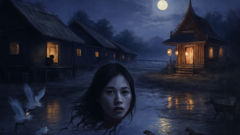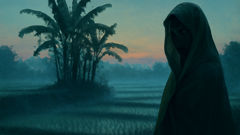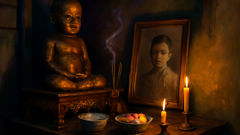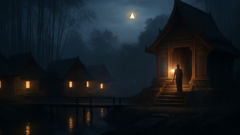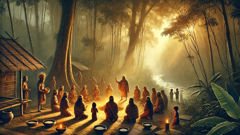Introduction
Under the flat, breathless moon of Thailand’s wet season, the world narrows to the rustle of leaves, the distant croak of frogs, and the slow, patient lapping of water in the rice paddies. Villagers shutter small houses and pull nets across lanterns, not merely against insects but against a name that brings a chill to the bones: Phi Krasue. In every telling the image is immediate and unnatural—an ordinary woman by day, sleeping or weaving, loved or scorned by kin; by night the body slumps in an oblivious heap while the head, hair streaming like kelp, slips free. It floats, viscera trailing, hunting in the dark for blood and raw flesh. This is not a ghost that lingers in attic shadows or mourns; it is a predator born of taboo and sorrow, a spectral anatomy that violates the neat boundaries of body and soul. The Krasue feeds on the intimate: offal from market stalls, flesh from slaughtered animals, and sometimes, the living. Across Thailand and neighboring lands—Laos, Cambodia, Malaysia—stories of the Krasue vary in color but not in dread. Here I tell a long account that stitches together origin myths, village rituals, first-person encounters, and the moral textures that keep the Krasue more than a creature of fear—an emblem of social boundaries, punishment, and the old ways that still shape nights around temple lanterns. You will walk the moonlit paths, learn the signs that a Krasue roams your fields, and meet a cast of villagers whose lives entwine with the ghost in ways both tragic and human. This is a tale meant to be read slowly, like listening to an elder beneath a thatch eave, tuned to the rhythms of frog-song and the keening wind.
Origins and Variations: Where the Krasue Came From
The Krasue's origins are a braided thread of belief, punishment, and misunderstood medicine. Folk etymology links the name to ancient words for "disembodied" and "wandering," but the legend swims upstream into older myths: spirits of women who breached ritual taboos, practitioners of forbidden sorcery, or victims of cruel accusations. In some accounts she was once a midwife who used sharp knowledge of anatomy and herbs and drew envy; in another she is a young woman cursed by a scorned lover. Across regions the precise cause of the transformation shifts—possession after childbirth, a curse uttered by a jealous sister, or a practice of necromancy gone wrong—but the core image remains: the head freed from its body, hunting when the world thinks it safe.

Anthropologists note that the Krasue and its variants—the Philippines' manananggal, Cambodia's krasueh, Malaysia's penanggalan—share cultural anxieties. These spirits target what is most intimate: blood, milk, and the entrails of livestock, threats that mirror everyday rural life where subsistence and bodily functions are public and communal. The Krasue story becomes a way to police those boundaries. A woman who travels alone at night, a midwife whose practices are not understood, a widow who shares too little with the kinship group—anyone could be suspected, and suspicion hardened into tale. The ghost functions as social regulation: cautionary lesson and channel for grief.
Natural phenomena also feed the legend. In the long wet seasons, carcasses left near the paddies attract scavengers; bright-eyed nocturnal animals peer out like small lanterns; people plagued by unexplained sickness or postpartum hemorrhage look for cause outside blood and bacteria and name it Krasue. The image of the head, hair like dark reeds, drifting with steaming entrails trailing, fills the void between medical ignorance and moral explanation. Folk remedies arise to counter this danger: against the Krasue’s passage, villagers scatter rice husks, place thorny twigs beneath window sills, smear lime and ashes on thresholds, and wrap shreds of cloth on the dead. Temple monks might chant and consecrate salt or amulets to ward off the creature. These rituals are as much community glue as defense—they summon shared attention and collective action that reassure a population at risk.
There are recorded historical moments when the Krasue legend played a public role. Colonial reports from the late nineteenth and early twentieth centuries collected strange accounts from rural officials, missionaries, and traders who noted how seriously villagers treated these tales. Early ethnographers recorded rituals performed by both Buddhist and animist practitioners, showing how belief in the Krasue threads through multiple religious frames. In wartime and famine, rumors of Krasue spread faster: fear needed a shape, and the Krasue offered one. Then, as radio and film brought city stories to the provinces, the Krasue migrated into new media, taking on cinematic twists while preserving the old terror. Horror films and popular ghost stories revived and reshaped the figure, sometimes making the Krasue more sympathetic, sometimes more monstrous.
But if we only treat the Krasue as social metaphor, we miss the tenderness braided through some old versions. A Krasue who once loved and was betrayed, who continues to hunger because the living denied proper burial rites—these narratives preserve pity. The ghost is not exclusively punishment; it is also a lament. In the quietest tellings, elders suggest that when a Krasue hovers over a house and a child is spared, it is because a woman in the kin provided rice and soot to the hungry spirit the night before. Such acts of small charity, performed to ward off supernatural appetite, double as communal memory: they bind villagers by reciprocity. To confront the Krasue is to see a culture wrestling with scarcity, hygiene, sex, and the fragile boundary between life and death.
Travelers who think of the Krasue as mere tale are often humbled by the policies and behaviors it enforces. In one Thai village, the rite to keep the Krasue away includes tying thorny vines into patterns above doorways. This practice, harmless in itself, also discourages strangers and agitators. The visual language of danger—ropes, thorns, salt lines—maps directly onto human relationships: where privacy matters, where certain bodies are kept in check. A woman suspected of being a Krasue might be watched, shunned, or cared for, depending on the village’s temperament.
As modernization etches new rhythms into rural life—electric lights, motorbikes, clinics—the Krasue’s territory shifts too. She moves from the shadows of thatched roofs to the glare of neon. Yet the tale persists because it addresses an evergreen human landscape: how a community explains catastrophe, assigns blame, and protects itself. The Krasue lives at the border between explanation and metaphor, between a name for what can’t be fixed with medicine and a story that keeps people mindful of the dark outside their doors.
(Imagery surrounding this section: An old lacquered map of a riverside village; a midwife’s herbs dried on bamboo racks; charcoal drawings of ghost heads aloft in rice fields; a monk scattering salt beneath a porch. The illustration shows the transition from mundane daily labor into moon-drenched nightmare—women pounding rice, children chasing crickets, then the sudden, impossible silhouette of a drifting head near the water’s edge, reflecting stars.)
Encounters, Rituals, and a Night with the Krasue
The stories that cling to the Krasue often arrive in the small, intimate register of confession. A farmer who once left an animal carcass too close to the house swears he saw the head appear above the bones the very next night. A child claims that a neighbor lady, long rumored to be cursed, snored beside a bale of straw while her head drifted past the door sucking raw meat from a hanging carcass. These reports are repeated in the market and at the temple, retold in a hundred slightly different cadences until they sit like a low hum across the village: there is danger beyond the threshold.

I was told one such account by Somjit, an elder who still tended his small plot of coconut palms and kept a photograph of his late wife in a silver frame. He spoke slowly, careful with the cadence of memory.
"It was the year the rains were late," he said, beginning as if the phrase itself were a charm. "Our pig fell ill. We barbecued what remained at the edge of the paddy so the dogs wouldn’t tear it. That night my youngest woke crying. He said there was a light in the yard and a woman with hair like riverweed. I laughed, the foolish laugh of a man who thinks the world is only what he can see. But when I went outside the dogs were gone, and the ash near the grill had been disturbed. We tied garlic to the rafters and the next day the woman two houses over had a fever. She slept by day like someone in a coma, and her family kept watch. We didn’t know then what to do, only that the old prayers might help. A monk from the next village lit incense and chanted for hours. We set up char marks and salt and in the morning no head was on the doorstep. But the woman… she never took up weaving again."
That story fits a common pattern: a disturbing nocturnal event, a communal response, an ambiguous resolution. Over time the rituals to repel a Krasue become codified. Salt is widely used, believed to sting supernatural flesh and drive the spirit away. In some places, cucumbers are hung from eaves because they are thought to distract and appease hungry spirits; in others, red chilies are burned to create acrid smoke. Families might place piles of ash or lime at thresholds; children are taught to sleep under covered cots so a Krasue cannot access them from above. Monks recite protective verses derived from Pali chants or local incantations. The amalgam of Buddhist ritual and animist practice here shows how belief systems adapt for practical protection.
Where the Krasue story takes a darker turn is in accusations. When someone in a village becomes suspect—an unmarried woman, a midwife, a woman with an unusual birthmark—rumor can escalate into a purge of the afflicted's reputation. In worst cases families ostracize the accused, sometimes to the point of violence. There are recorded instances where women who consulted herbalists or engaged in secret fertility practices were suspected of Krasue-sorcery. Fear, scarcity, and passion conspire to make supernatural explanations for natural things: a postpartum hemorrhage becomes proof of curse; a stray animal attack becomes evidence of haunted hunger.
My most vivid night with the Krasue began as an assignment: to understand how contemporary villagers cope with old fears, I spent a month in a cluster of houses on the river splaying out from a provincial town. The family where I stayed—Aunt Daeng, her son Nop, and Nop's small niece—were ordinary people who rose before dawn to tend chickens and returned after dusk to sit by a single television. They told me the Krasue story not as myth but as a ritual map: what to do, how not to carry shame, how to live. "At night you don't whistle," Aunt Daeng said, "and you don't sweep the doorway, and if you hear someone calling your name from the paddy, don't go. Wait until dawn." I followed these faux-superstitions partly in jest and partly out of curiosity.
One night, about three weeks into my stay, the lights failed. A bright, electrical flash—lightning or a transformer—died, and the world thinned to a handful of lamp-lit houses and a sky beaded with stars. There was a wind that pushed like breath through the rafters. Nop's niece awoke and whimpered; she had been having a nightmare about a woman missing her feet. A dog started and ran in circles. Then, a sound I cannot name: the soft, wet sucking of something that does not belong to the night. It was not the hum of insects or the croak of frogs, but a close, deliberate motion, like lips parting a fruit. We froze.
The family sprang into action, not with panic but with training. Salt was fetched from the kitchen and flung in a scatter across the threshold. A few sticks of burning dried chili were held in the doorway to create an acrid smoke. Aunt Daeng began a low chant, a string of words that mixed Pali with local phrases. The child clutched a rabbit's foot charm and hummed. For a full hour we waited, listening to the sucking sounds—intermittent, as if the creature were sampling the air—until the dog barked and the noises faded. In the morning, we found small, dark stains near where the carcass had been last week. There was no head; only the damp track of something that had eaten and drifted away.
The family did not call in law enforcement or doctors; they called a monk. Religious authority here is less about institutional power and more about auspicious knowledge. The monk drew a circle of salt, muttered protective lines, and the family presented offerings: rice, bael fruit, and boiled eggs. In exchange for these tokens, the villagers believed, the spirit might be sated or at least deterred for a time. These tokens are not magic in a technical sense; they are social devices: they make fear visible and manageable, transforming anxiety into an ordered ritual.
I asked Aunt Daeng later if she believed the Krasue was truly a head that floated with dripping entrails. She smiled, not with mockery but with the kind of acceptance that knows when metaphor and danger intersect. "Whether she is a ghost or not," she said, "doesn't always matter. The rules she taught us keep us alive. Maybe the head is a dream to explain things we cannot explain. Maybe it's a way to say: take care of your babies, keep your animals, be mindful of what you throw away."
Yet belief is stubborn. Years later, a woman in a nearby village accused of being a Krasue was driven from her home. She returned years after, worn and quiet, and told a story of hunger and shame. Those looking for justice and those looking for retribution found the same myth and asked different questions of it. Where one sees superstition, another sees deserved punishment; where one sees social control, another sees an instrument of safety. The Krasue keeps the contradictions of communal life in plain sight.
(Imagery accompanying this section: A dim interior of a wooden house where salt is scattered across the threshold; a monk leaning over an incense brazier; a child's silhouette under a mosquito net; a late-night puddle reflecting a pale, impossible face. The picture lingers on the human action—small hands flinging salt, the motion of someone chanting—and then pans out to the lonely field where a head might have drifted.)
Conclusion
The Krasue endures because it is more than a shadow story told to frighten children. It is an emblem of the small economies of care that keep a village alive: how neighbors share food, how families protect newborns, and how rituals patch the breach between what science can fix and what communities fear. In some versions the Krasue is monstrous and vengeful, in others she is pitiful, a woman wronged and punished by rumor. Either way, the tale contains an insistence: bodies are vulnerable, and societies must decide how to treat those vulnerabilities. As Thailand modernizes and clinics edge closer into once-isolated hamlets, the literal conditions that birthed Krasue tales change, but the human anxieties they encode—over sex and fertility, shame and scarcity, the boundary between community and otherness—are stubborn. Ghost stories like this survive because they do work: they name fright, prescribe practices, and build a language of resistance and care. When you hear the rustle by the paddy, when a dog barks at the dark, you hear an echo of generations inventing explanations and protections. Whether the Krasue is a floating head or a metaphor, the villagers' responses—salt, chant, shared offerings—are real. They stitch community in nights that are long, uncertain, and often wet with rain. In the end, the Krasue is a reminder: to watch the thresholds, tend the hungry, and keep alive the rituals that transform fear into action.

